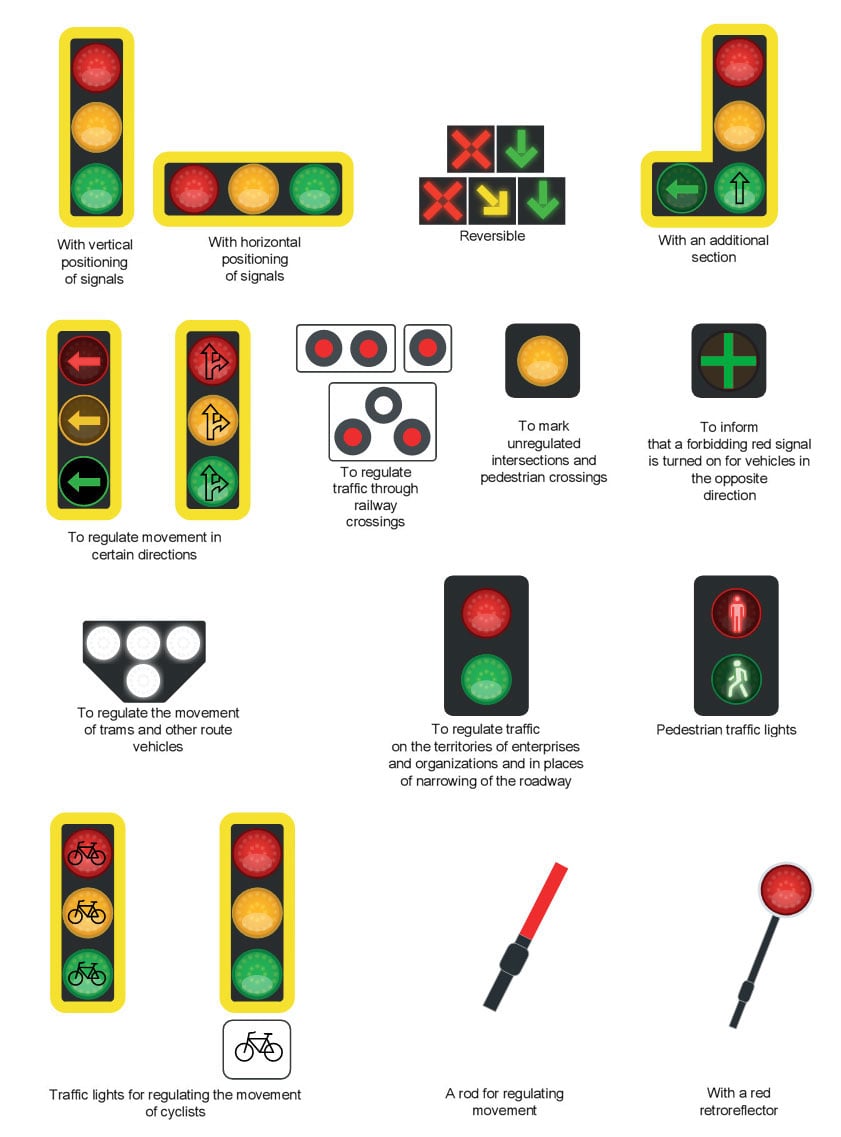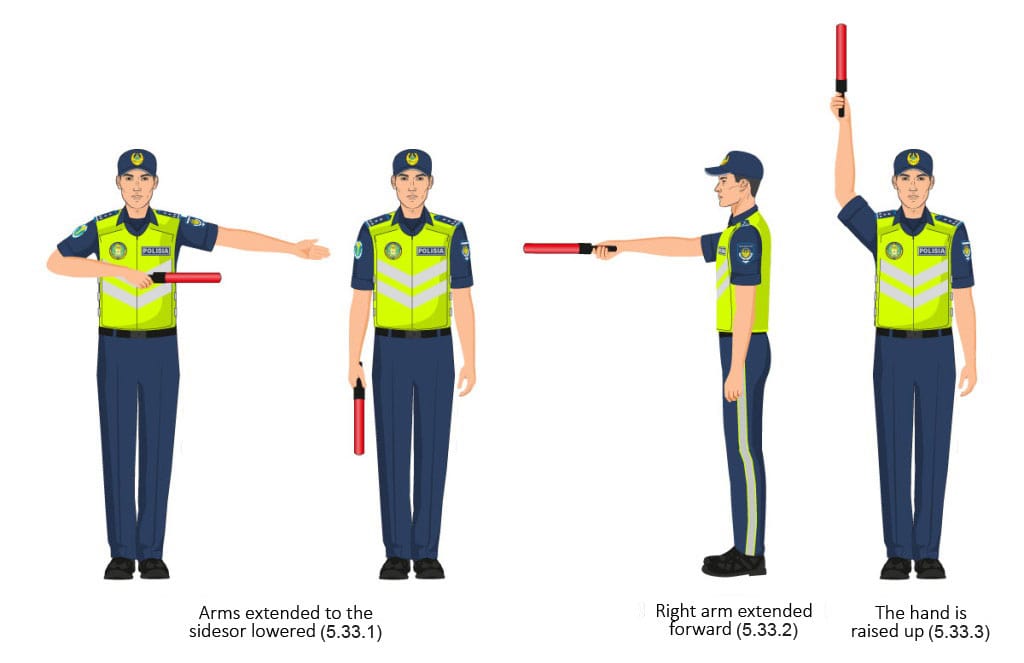Traffic light signals
23. To regulate traffic, traffic lights with a vertical or horizontal arrangement shall be used.
Light signals of green, yellow, red and white-lunar colour shall be used in traffic lights.
In traffic lights with a vertical arrangement of signals, the red signal shall be placed at the top, and the green one shall be at the bottom; with a horizontal arrangement of signals – red shall be placed on the left, green – on the right.
Depending on the purpose, traffic light signals may be round, in the form of an arrow (arrows), a silhouette of a pedestrian or a bicycle, “X” and “+”-shaped.
Traffic lights with round signals may have one or two additional sections with signals in the form of a green arrow (arrows), which shall be located at the level of the green round signal.
24. Round traffic lights shall have the following meanings:
 1) green signal allows movement;
1) green signal allows movement;
2) green flashing signal allows movement and informs that its time expires and a prohibition signal will soon be turned on (digital displays shall be used to inform drivers and pedestrians about the time in seconds left before the green signal turns off);
 3) yellow signal prohibits movement, except for the cases provided for in paragraph 14 of this section, and warns of the upcoming change of signals;
3) yellow signal prohibits movement, except for the cases provided for in paragraph 14 of this section, and warns of the upcoming change of signals;
4) yellow flashing signal informs about the presence of an intersection or a pedestrian crossing that is not regulated by a traffic light and warns of danger;
 5) red signal, including flashing, prohibits movement. The combination of red and yellow signals prohibits movement and informs about the upcoming green signal.
5) red signal, including flashing, prohibits movement. The combination of red and yellow signals prohibits movement and informs about the upcoming green signal.
25. Traffic light signals made in the form of red, yellow and green arrows shall have the same meaning as round signals of the corresponding colour, but their effect shall extend only to the direction (directions) indicated by the arrows. In this case, the arrow that allows a left turn shall also allow a U-turn unless this is prohibited by the corresponding road sign.
Instead of red and yellow arrows with the same meaning, round red and yellow signals with black contour arrows printed on them may be used.
The green arrow in the additional section shall have the same meaning. The switched-off signal of the additional section shall mean the prohibition of movement in the direction regulated by this section.
26. If a black contour arrow (arrows) is applied to the main green signal of the traffic light, then it shall inform drivers about the presence of an additional section of the traffic light and indicate other permitted directions of movement than the signal of the additional section.
27. If the traffic light signal is made in the form of a silhouette of a pedestrian (bicycle), then its effect shall apply only to pedestrians (cyclists). In this case, the green signal allows, and the red one prohibits the movement of pedestrians (cyclists).
To regulate the movement of cyclists, a traffic light with round signals of reduced size shall also be used, supplemented by a white rectangular plate 300×200 mm in size with the image of a black bicycle.
28. To inform blind pedestrians about the possibility of crossing the carriageway, traffic light signals may be supplemented with an audible signal.
29. To regulate the movement of vehicles on the lanes of the carriageway, in particular on those where the direction of movement may be reversed, reverse traffic lights with a red X-shaped signal and a green signal in the form of an arrow pointing down shall be used. These signals shall respectively prohibit or permit movement in the lane above which they are located.
The main signals of a reversing traffic light may be supplemented by a yellow signal in the form of an arrow, tilted diagonally down to the right or left, the inclusion of which informs about the upcoming signal change and the need to change lanes to which the arrow points.
When the signals of the reversing traffic light, which is located above the lane marked on both sides with markings 1.9, are turned off, entry to this lane shall be prohibited.
30. To regulate the movement of trams, as well as public transport, moving along the lane allocated for them, single-colour signalling traffic lights with four round white-lunar signals arranged in the form of the letter “T” shall be used. Movement shall only be permitted when the lower signal and one or more upper ones are turned on, of which the left one shall allow movement to the left, the middle one – straight ahead, the right one – to the right.
31. Round white-lunar flashing signal, located at the level crossing, shall allow the movement of vehicles through the crossing. When the flashing white-lunar and red signals are turned off, the movement shall be permitted if there is no train (locomotive, railcar) approaching the crossing within sight.
32. The red “+”-shaped signal shall inform that for the vehicles in the opposite direction, the prohibiting red traffic light is turned on.
The turned-off red “+”-shaped signal shall inform that the permissive green traffic light is on for vehicles in the opposite direction.

Traffic warden signals
33. The signals of the traffic warden shall be the position of his body and gestures with his hands, including with a baton, which has the following meanings:
1) arms extended to the sides or lowered:
from the left and right side – the tram shall be permitted to move straight, trackless vehicles and to the right, pedestrians are permitted to cross the carriageway;
from the side of the chest and back – the movement of all vehicles and pedestrians shall be prohibited.
2) the right hand is extended forward:
from the left side – the tram shall be permitted to move to the left, with trackless vehicles in all directions;
from the side of the chest – all vehicles are permitted to move only to the right;
from the right side and back – the movement of all vehicles shall be prohibited;
Pedestrians shall be permitted to cross the carriageway behind the back of the traffic warden.
3) hand raised:
the movement of all vehicles and pedestrians shall be prohibited in all directions, except as provided in paragraph 14 of this section.
The traffic warden may give hand gestures and other signals understandable to drivers and pedestrians.
For better visibility of the signals, the traffic warden may use a baton or disk with a red signal (reflector).
34. The request to stop the vehicle shall be submitted with the help of a loudspeaker, a hand gesture or a baton directed at the vehicle with a simultaneous whistle signal, which must be understandable to the driver and given on time so that their execution shall not create an emergency.
35. An additional whistle signal shall be given to attract the attention of traffic participants.
36. With a prohibitory signal of a traffic light (except for a reversing one) or a traffic warden, drivers shall stop in front of the stop line (sign 5.33), and in its absence:
1) at the intersections – in front of the crossed carriageway or shall be guided by the requirements of paragraph 8 of section 13 of the Rules, without interfering with pedestrians;
2) before a level crossing – in accordance with paragraph 4 of section 15 of the Rules;
3) in other places – in front of a traffic light or a traffic warden, without interfering with vehicles and pedestrians whose movement shall be permitted.
37. Drivers who, when the traffic warden raises his hand or turns on the yellow signal in cases where the mode of operation of the traffic signal does not ensure the flashing of the green signal immediately before it turns off, cannot stop without resorting to emergency braking in the places specified in paragraph 13 of this section, shall keep moving forward.
Pedestrians who, when the traffic warden raised his hand or turned on the yellow signal, were on the carriageway of the road, clear it, and if this is not possible, shall stop on the line dividing the traffic flows of opposite directions.
38. Drivers and pedestrians shall comply with the requirements of the signals and orders of the traffic warden, even if they contradict traffic signals, traffic signs or markings.
39. At level crossings, simultaneously with a red flashing traffic light, an audible signal may be given, additionally informing traffic participants about the prohibition of movement through the crossing.

Gestures of the traffic controller in pictures with explanations
